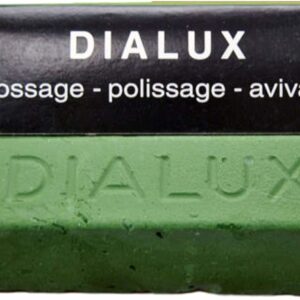Hello
After experimenting with sharpening my plane irons (hand sharpening with 600 and 1200 diamond stones, then go straight to bench grinder with buffing wheel and compound) I noticed I have a problem with my compound.
Probably two years ago I bough a Dialux Green compound for steel. It has never be soft but rather hard product which becomes more soft with temperature going up.
But it seems to me that I can not put compound on the buffer wheel correctly. I turn on the wheel, and go with very light touches to warm up a bit the compound. It becomes warm but still if I am press too hard, the compound will just fly away and make a gaint mess.
So I am not sure if I apply it correctly and in proper amount. Once I noticed is that I could not polish the edges of plane irons enough, so I put more compound and the edge was sharp again.
I do have 8 spare blades for Stanley Nr. 4 and 5, and each time when I have to polish one blade, I apply light touch of compound to be sure there is enough of it. For the next blade I again apply a light touch and polish it (3-4 times on buff wheel).
What do you use and how do you use your compound?
Thanks.
Discussion Forum
Get It All!
UNLIMITED Membership is like taking a master class in woodworking for less than $10 a month.
Start Your Free TrialCategories
Discussion Forum
Digital Plans Library
Member exclusive! – Plans for everyone – from beginners to experts – right at your fingertips.
Highlights
-
Shape Your Skills
when you sign up for our emails
This site is protected by reCAPTCHA and the Google Privacy Policy and Terms of Service apply. -
 Shop Talk Live Podcast
Shop Talk Live Podcast -
 Our favorite articles and videos
Our favorite articles and videos -
E-Learning Courses from Fine Woodworking
-
-
 Fine Woodworking New England Event
Fine Woodworking New England Event -













Replies
I just put it on and let it get messy. Sometimes a spritz it oil can help it stick and really saturate.
Are you using a stiff wheel? You don’t want one of the fluffy ones.
I have something like this:
Those are really for buffing, not sharpening. Over time you're just going to cause yourself a lot of grief by trying to "sharpen" on those.
You were doing fine with the stones, you were just stopping at a very course grit. Skip the strops and buffing wheels. 1,000 - 4,000 - 8,000 and you're done. 2 minutes on a tool that's not damaged.
@john_c2... The buffer isn't for sharpening, even though it's called that, and it creates NO damage to the tool when used correctly as you only buff the bevel. It's for finishing the edge. You create your bevel/facet on the stone. Buffing reduces the scratches to a micron level not achievable even with a 30,000 grit Shapton. It also slightly bullnoses the trailing edge of the facet (not the back of the tool) making the edge stronger which improves the performance to a level not achievable with any stones of any type. It improves durability more than twofold therefore less sharpening. The technique is not to "Sharpen" using the buffer. But to enhance the edge and is only performed on the bevel. I teach this method to my peers at the local WW Guild and have created many converts from quite a few "Ole Timers". Their reaction was the same as yours until they tried it. They learned quickly and they now include the buffing in their repertoire and state that they will never sharpen again without finishing on the buffer. This process eliminates stropping. I also teach it to beginners who take it as part of "This is how you sharpen". When they achieve paper cutting sharpness on their first attempt the grin on their face is priceless. Give it a try. I promise you'll never go back😁. Talk to some carvers and turners that finish with a buffer. They'll not ever finish sharpening without the buffer.
This also works for kitchen knives which results in fewer sharpening's. With the knives you do buff both sides. My wife has her favorite knives and food prep has become less of a chore, especially when cutting tomatoes. I find that I don't sharpen her knives as frequently as before.
The other benefit to finishing on the buffer is that you can convert your old "beaters" to everyday uses. Cheap chisels and plane blades can become your friends and help your budget. Counterintuitive, eh?
I would look for something specifically hard.
Relax, all is fine. Your buffing wheel needs to be very saturated. Until it is you may have to warm the compound to get it to transfer easily. After it is "broken in" you'll be just fine. You won't see the compound transfer change the color of the buffing wheel surface, however it will transfer. Check out this video from Weaver regarding the buffing wheel. https://www.youtube.com/watch?v=HBrPTZob_bM
Good luck.